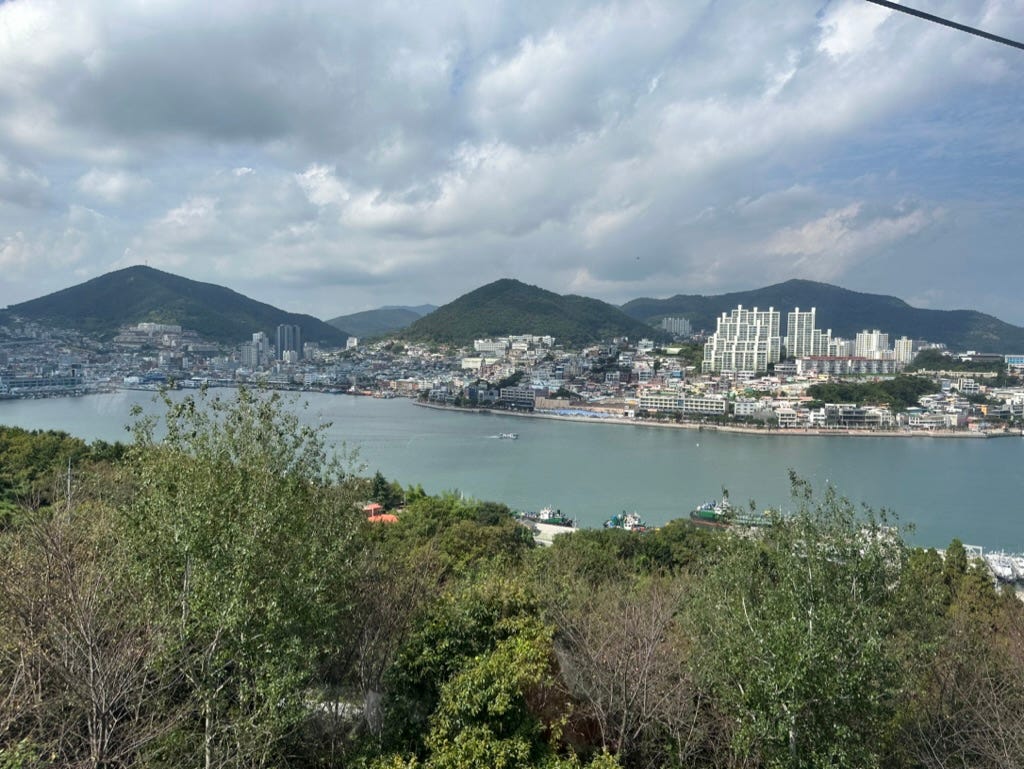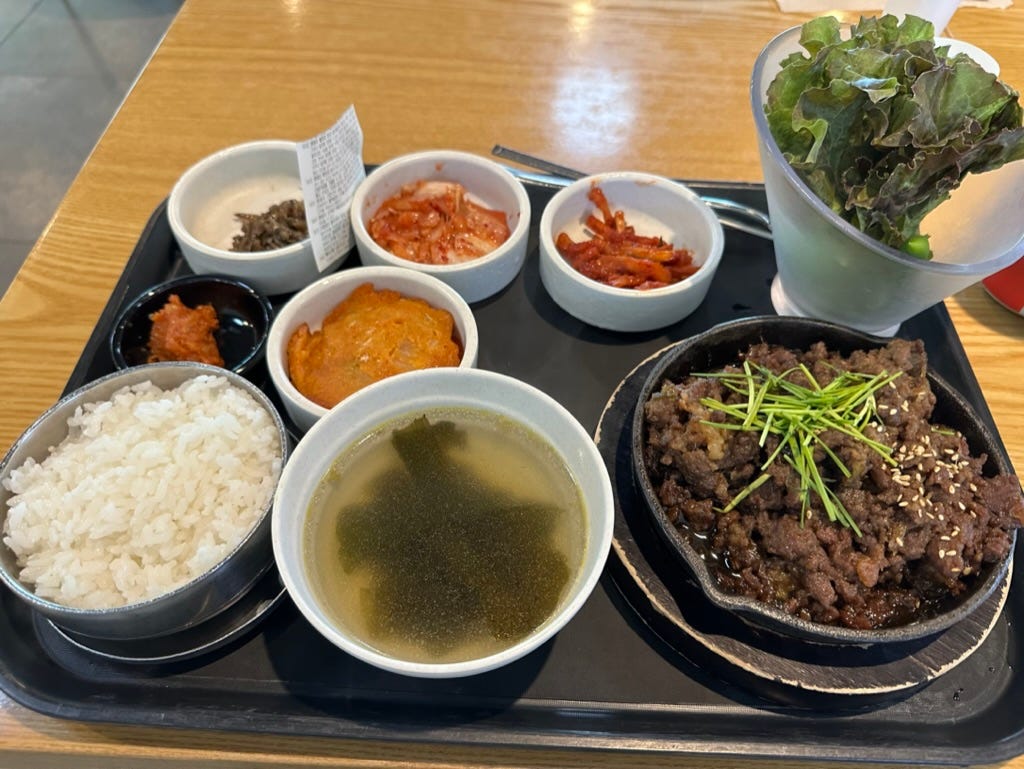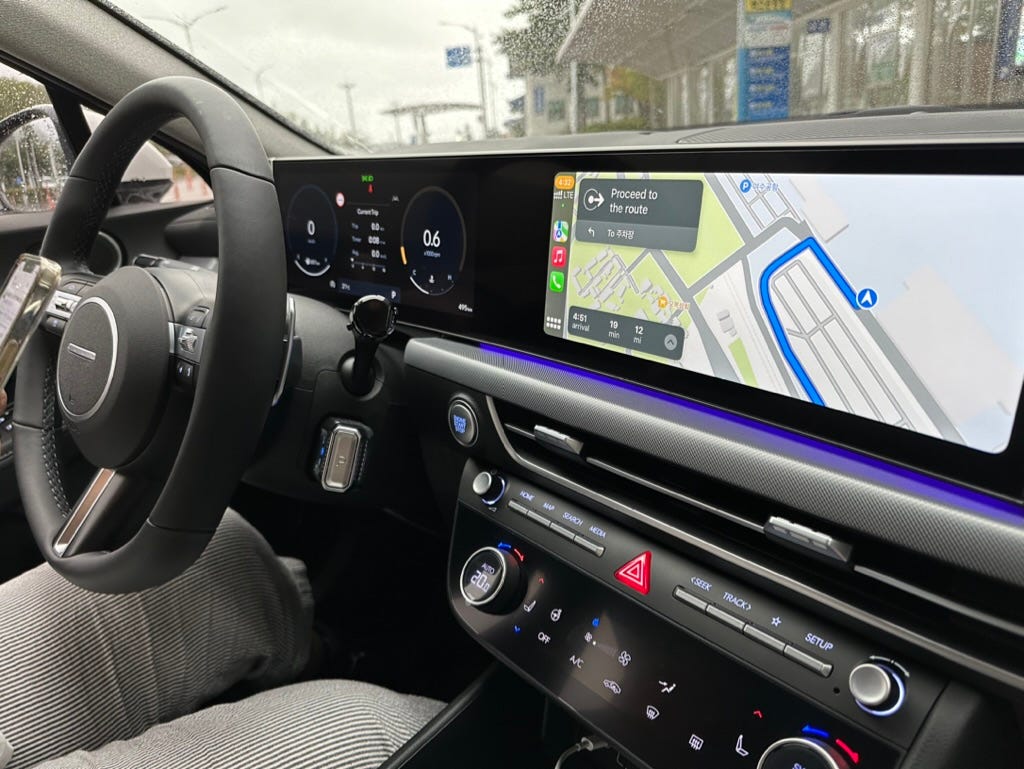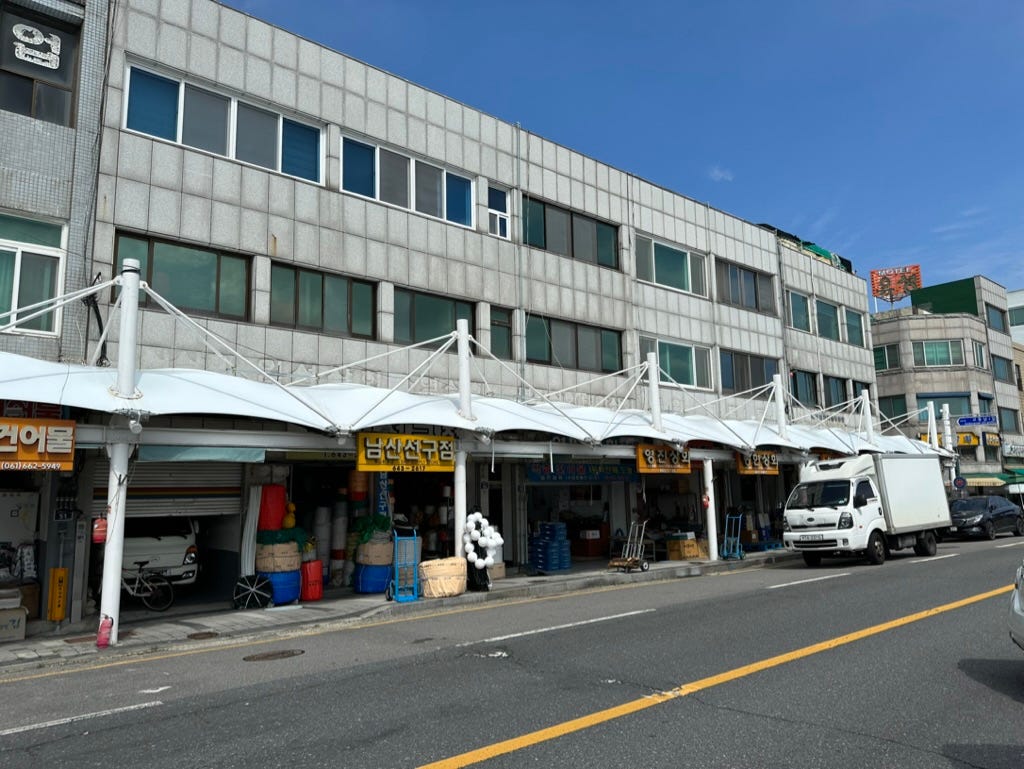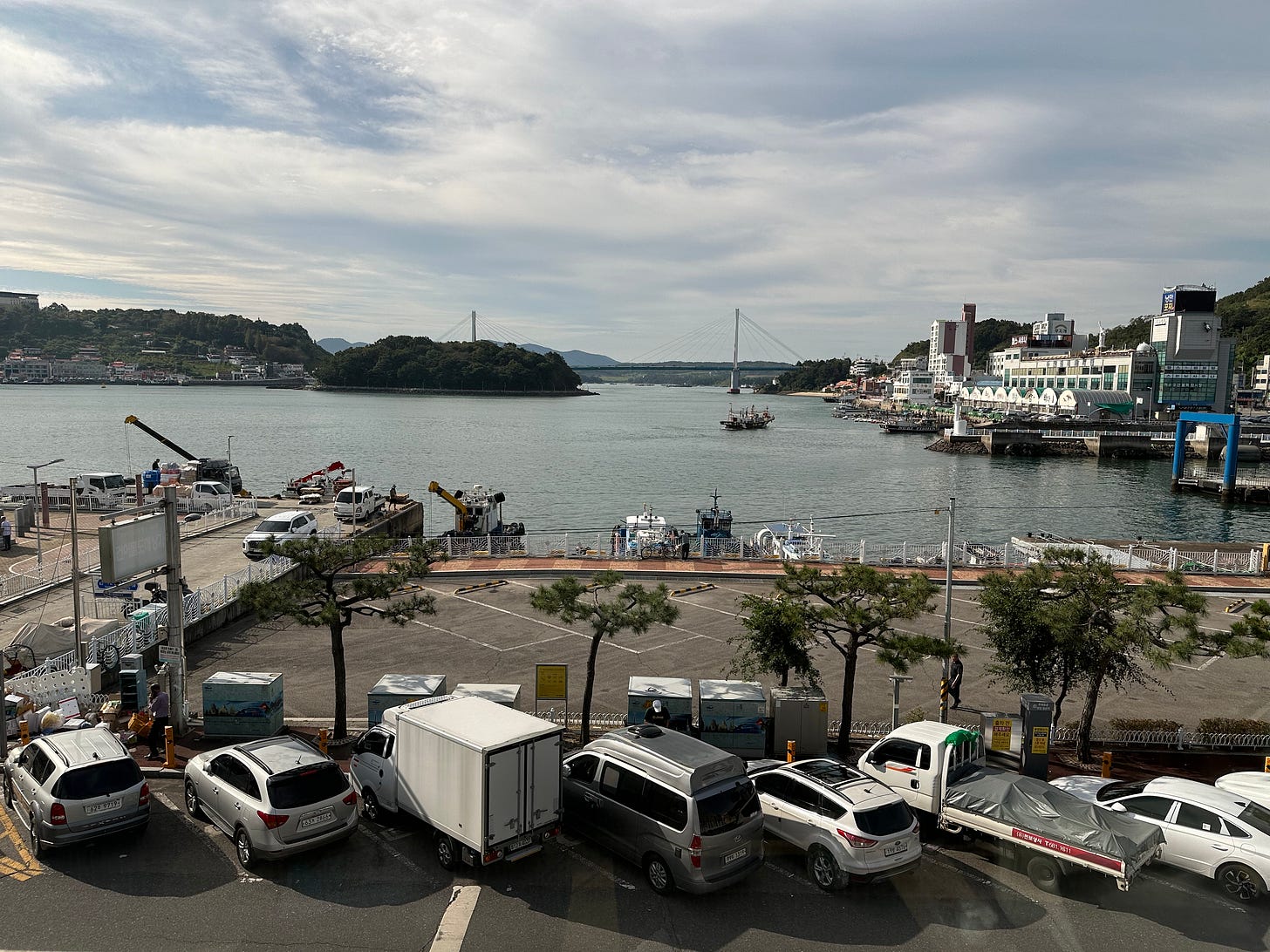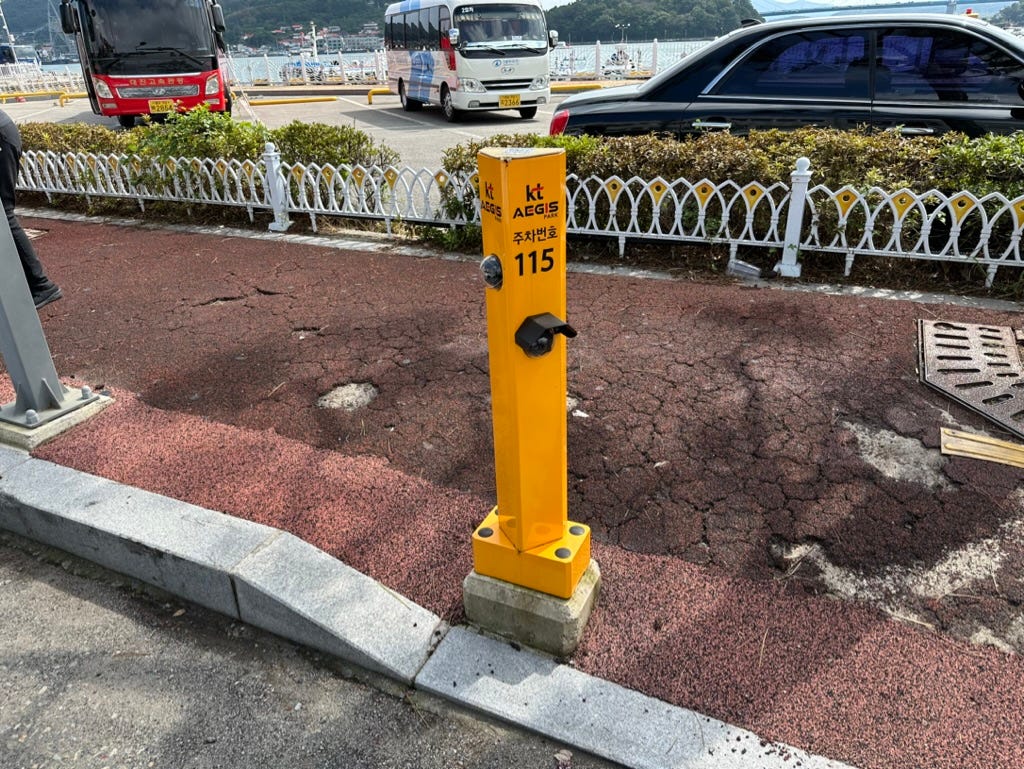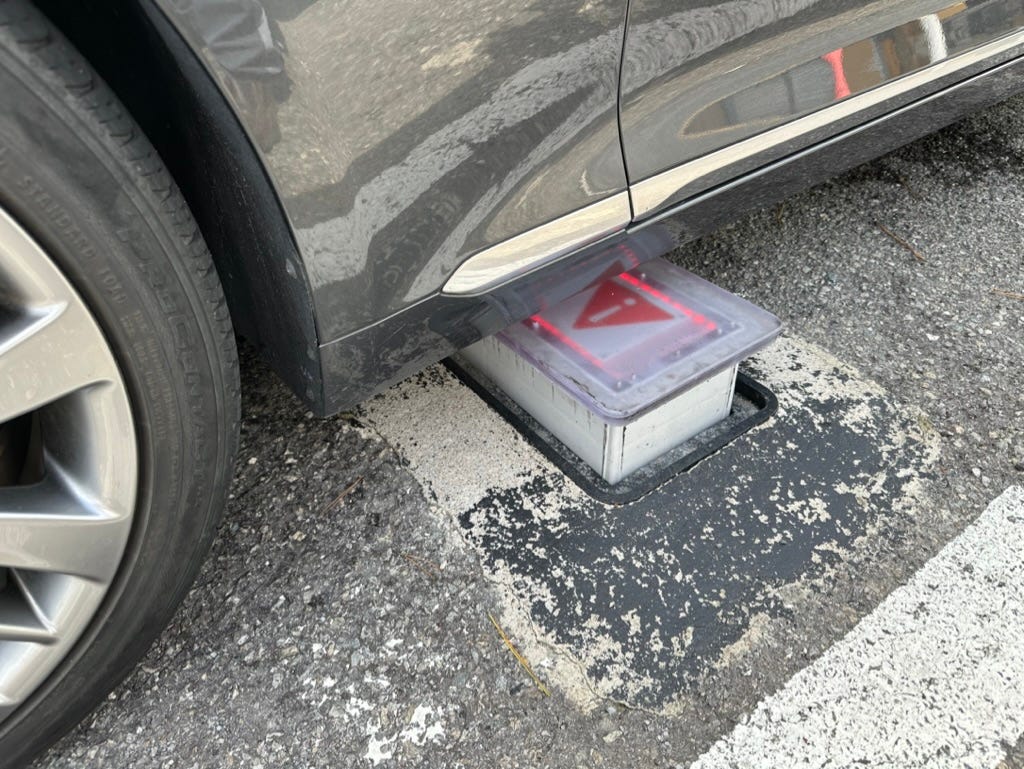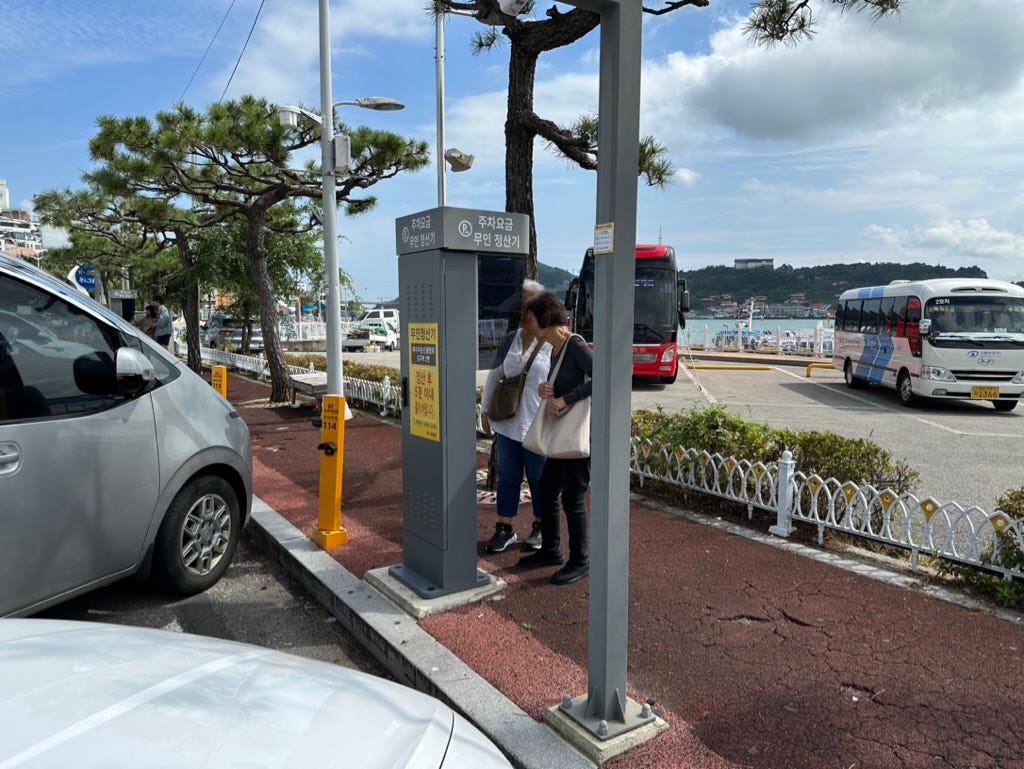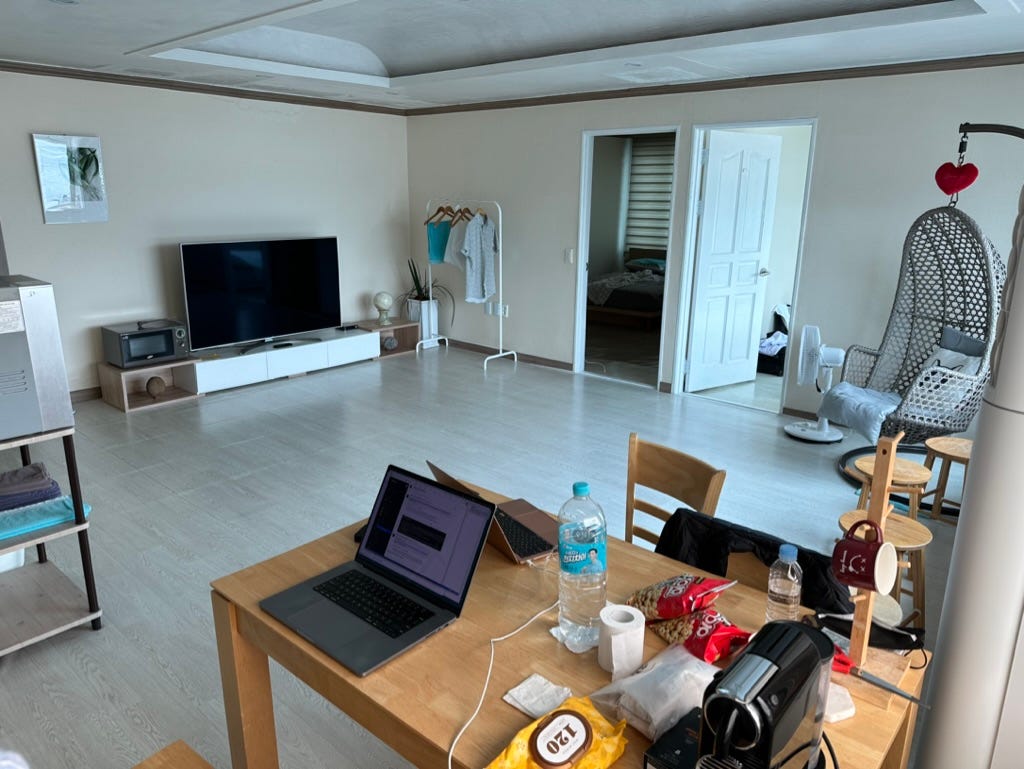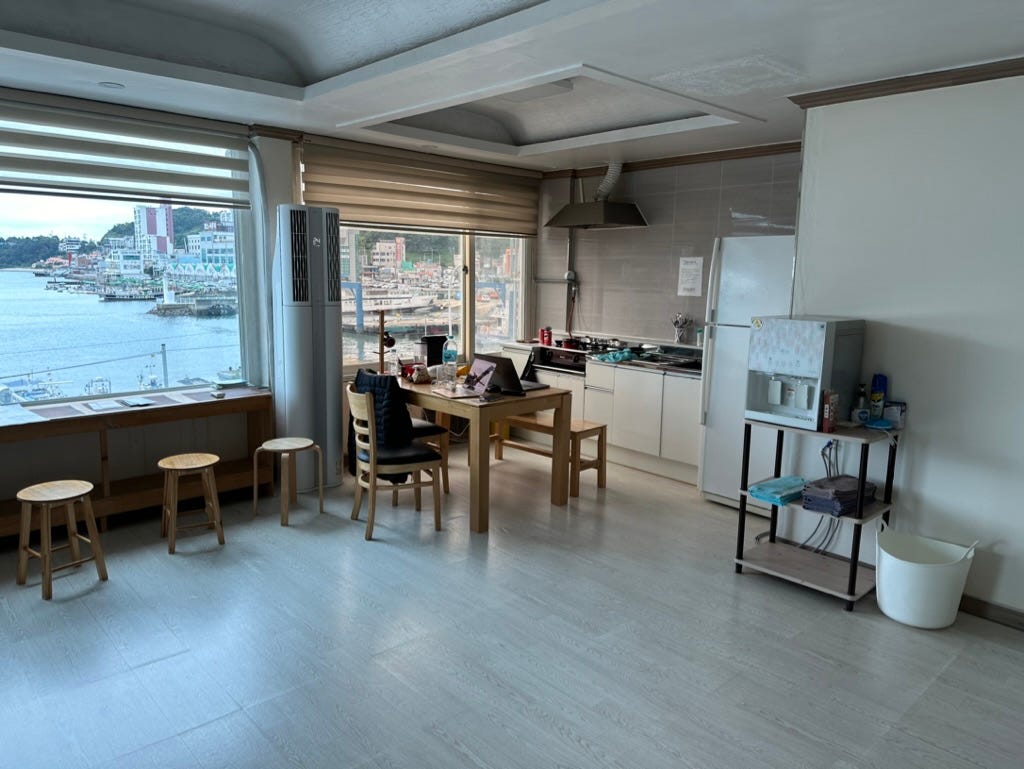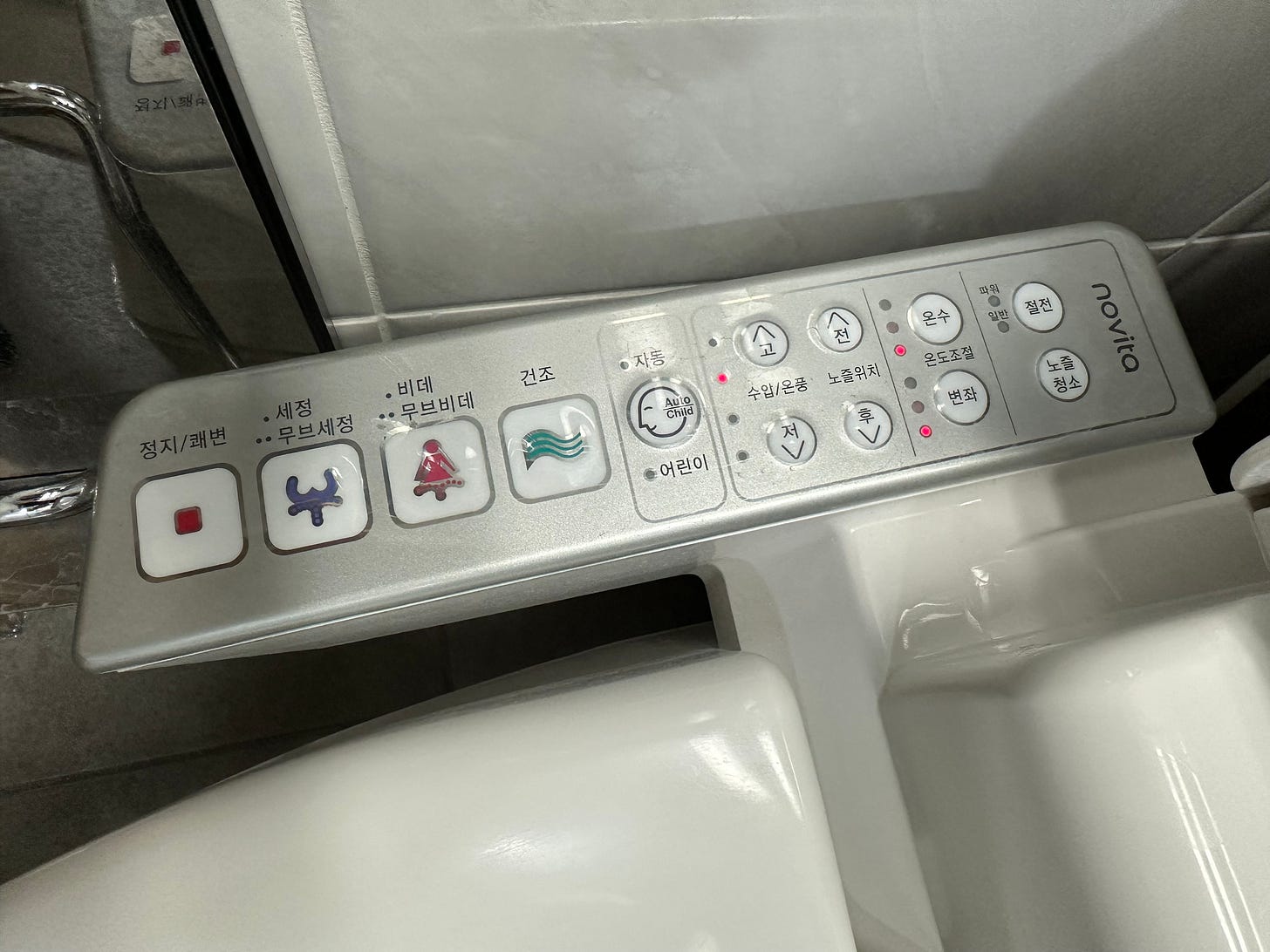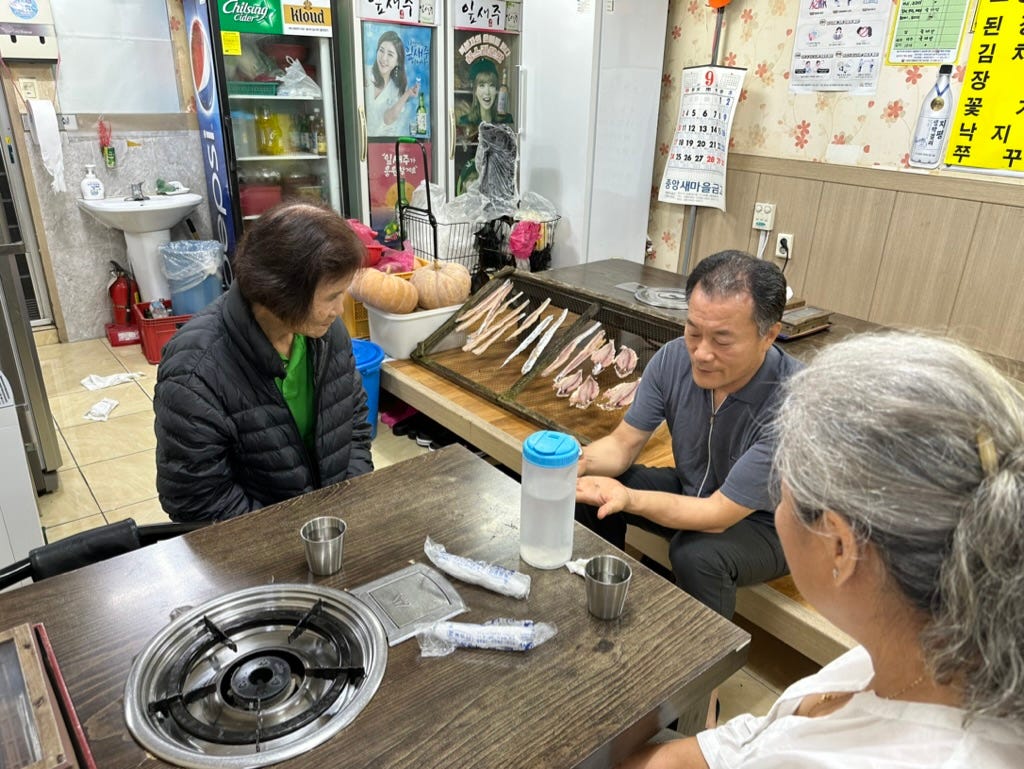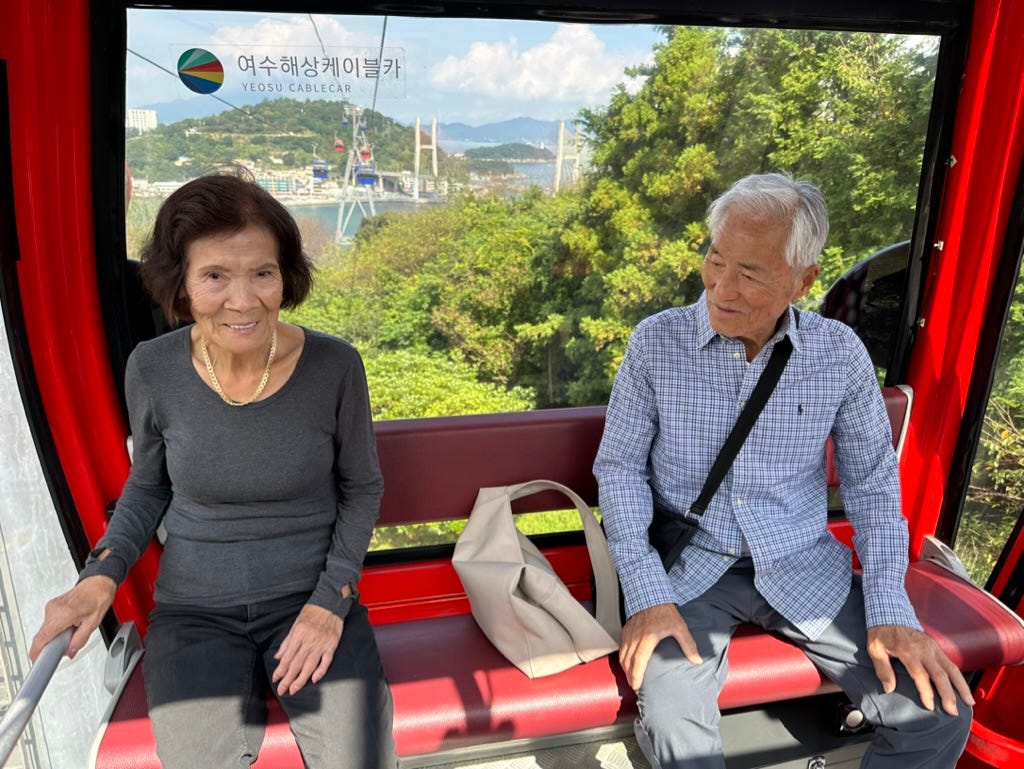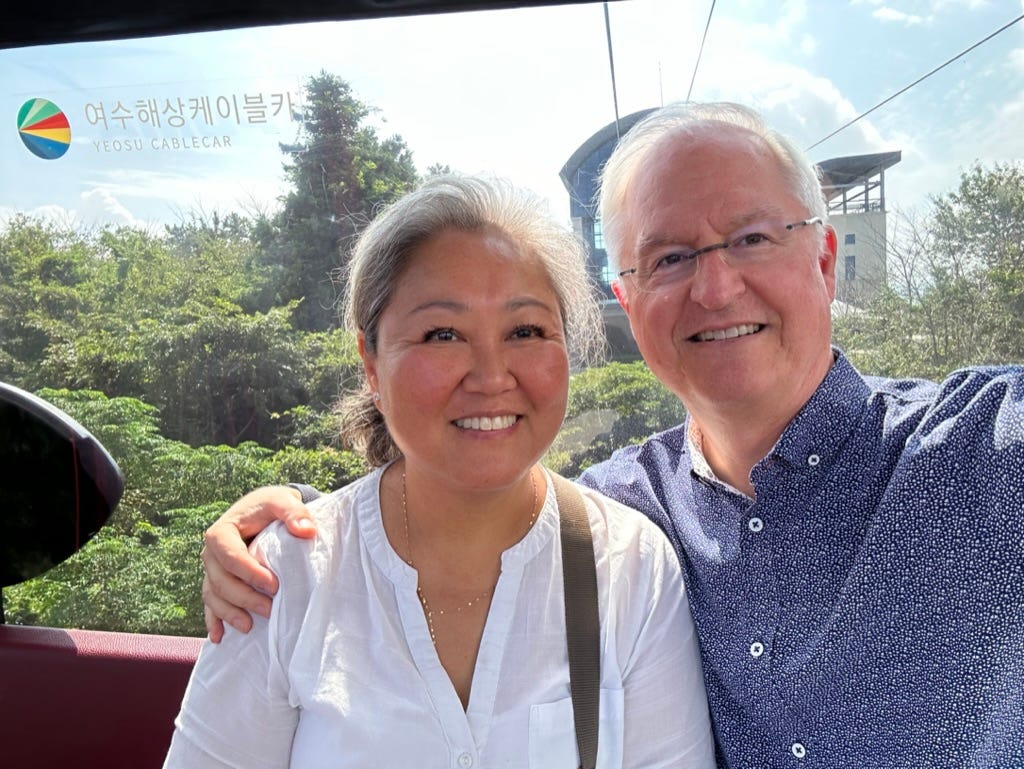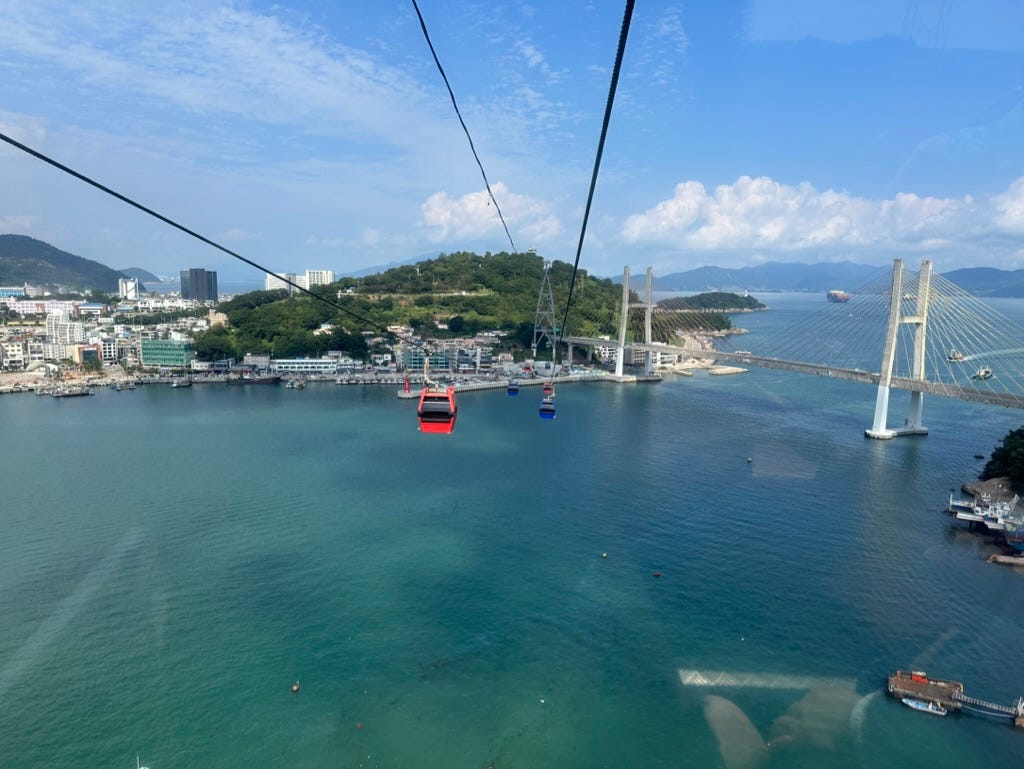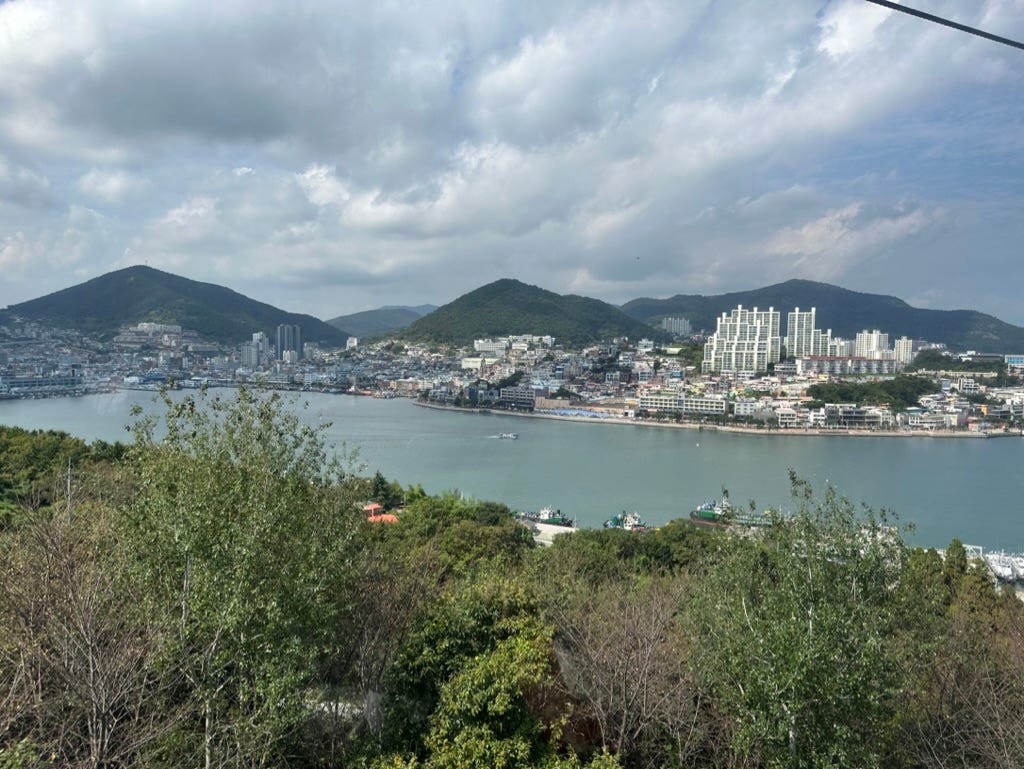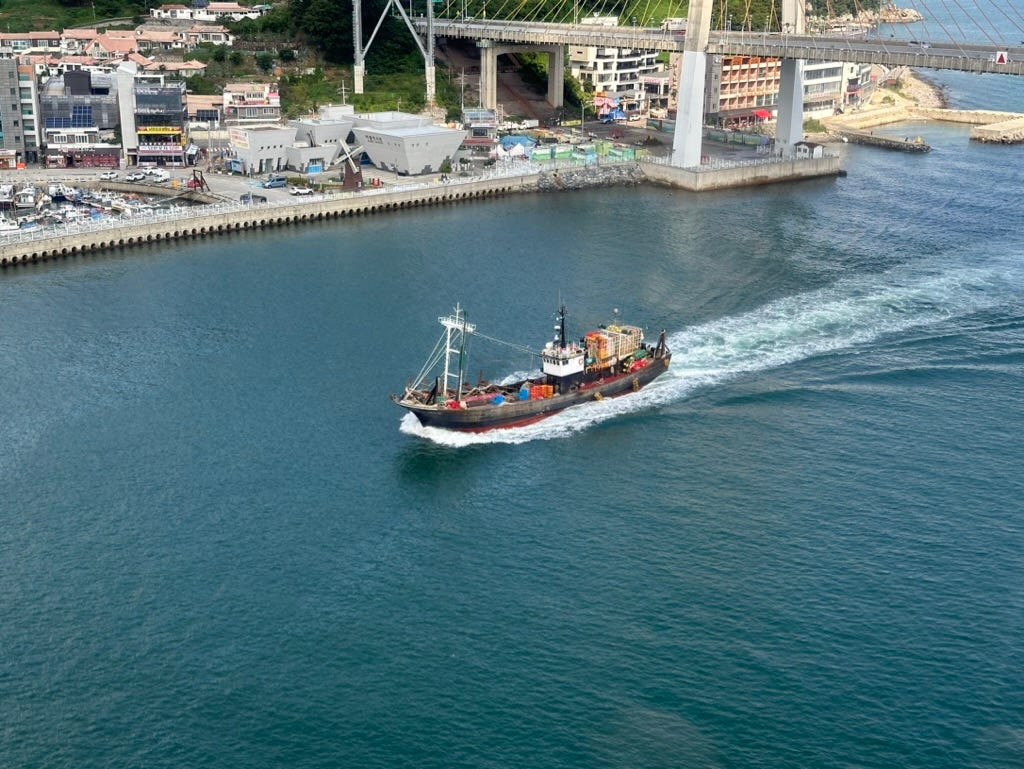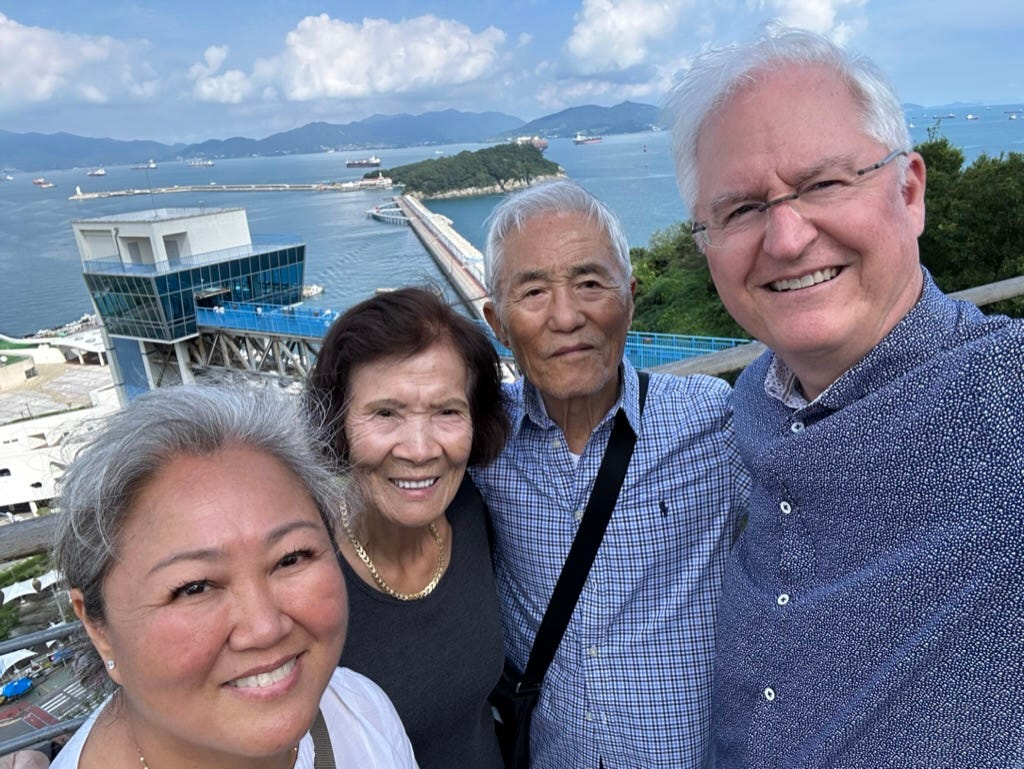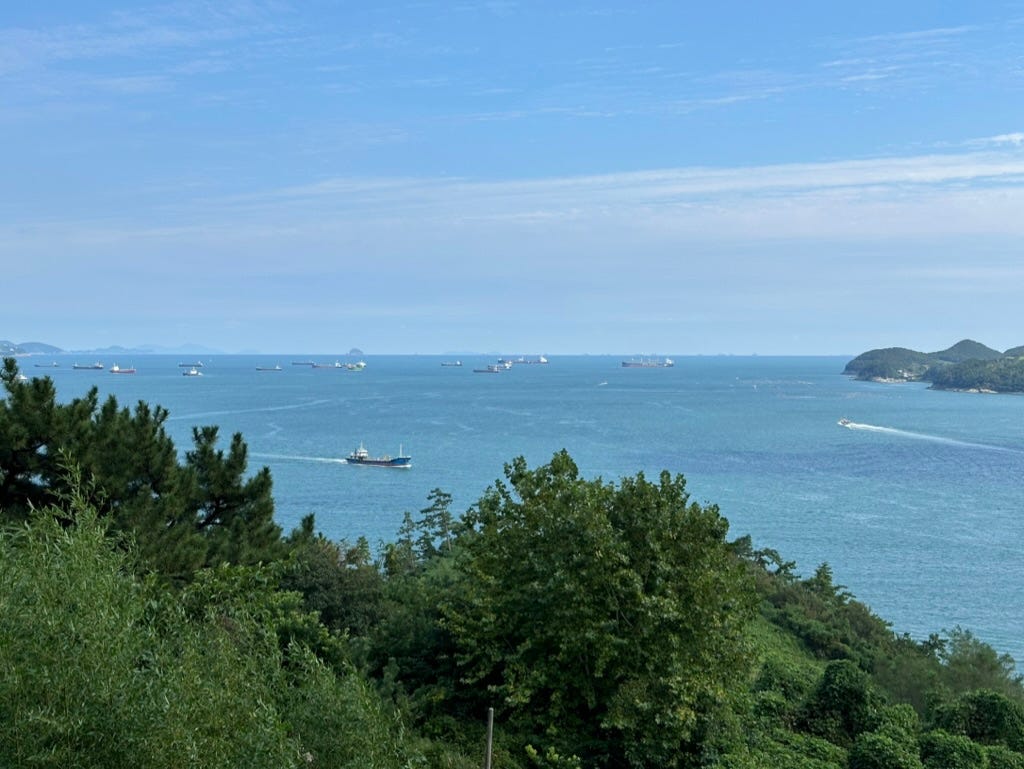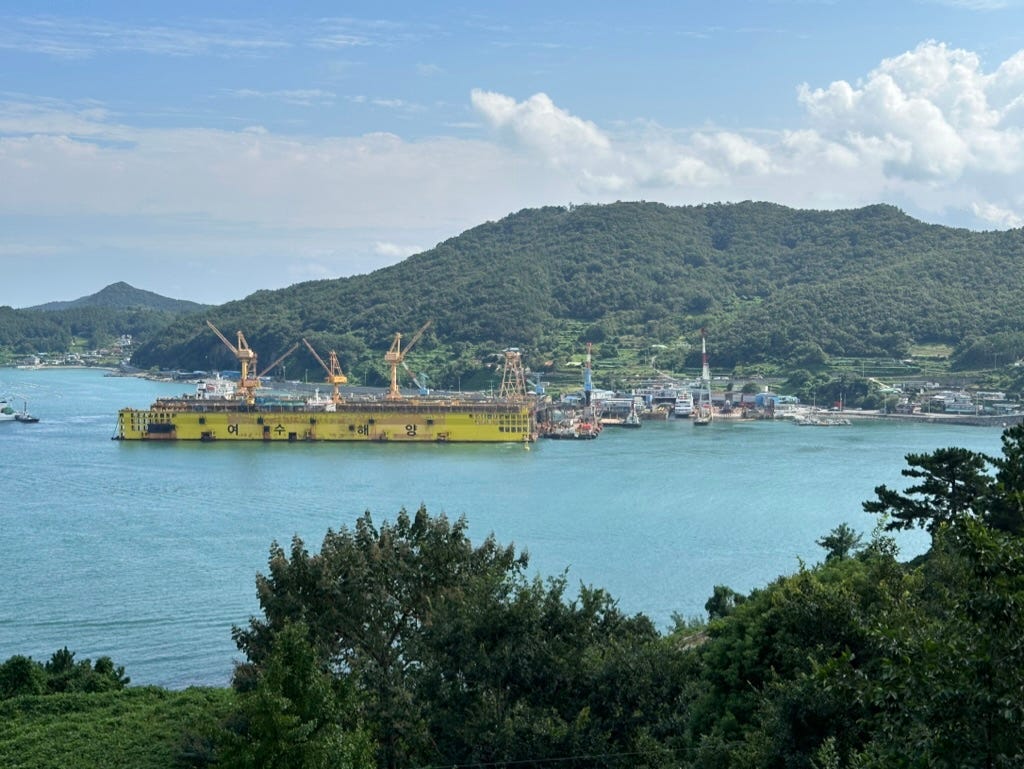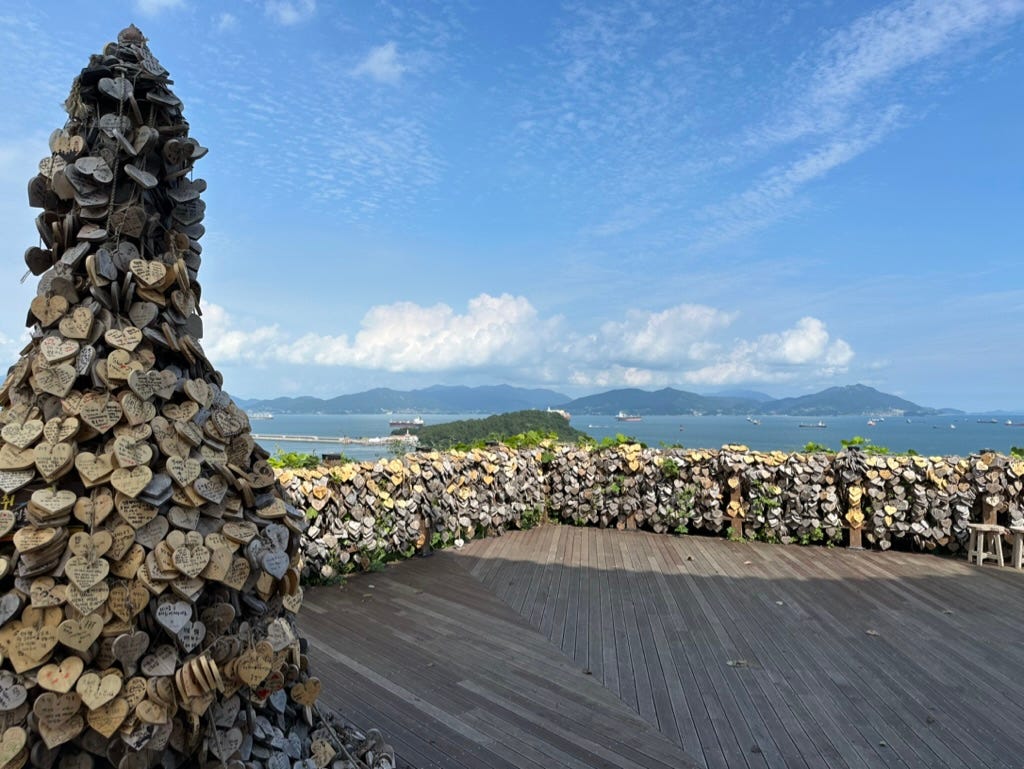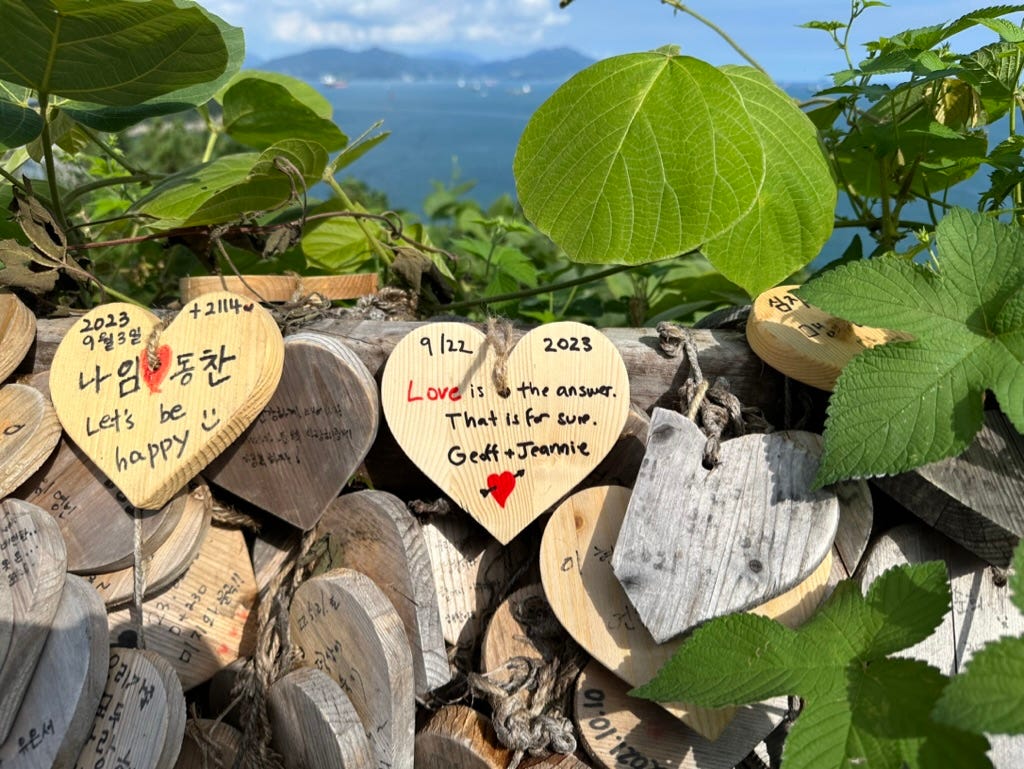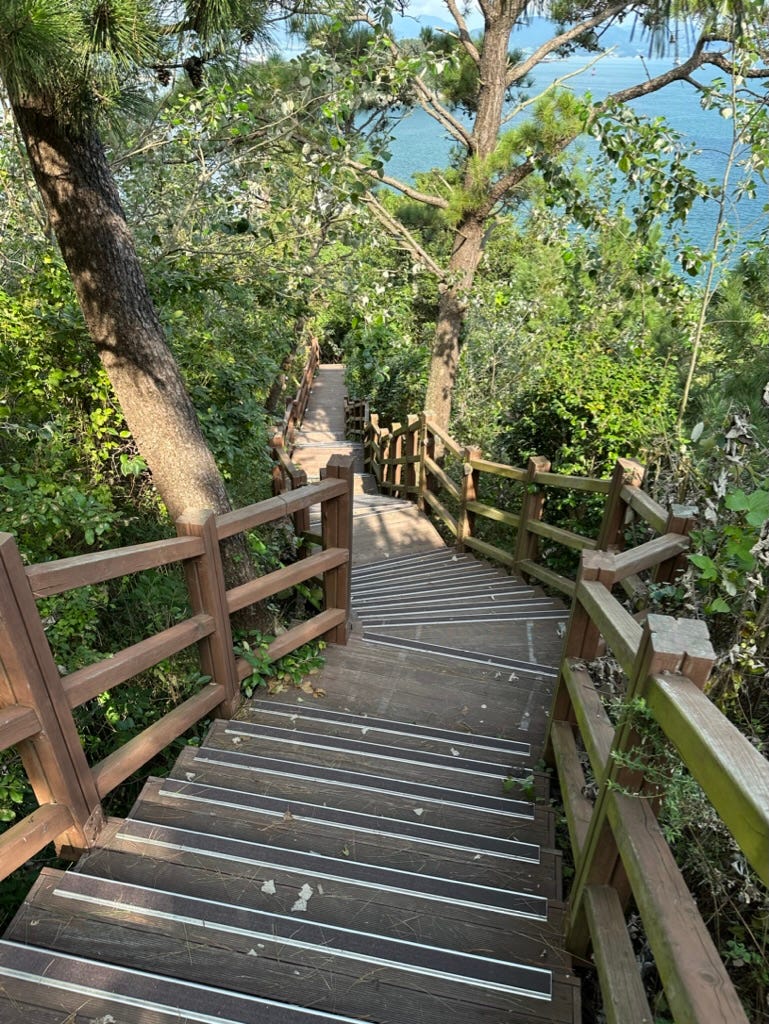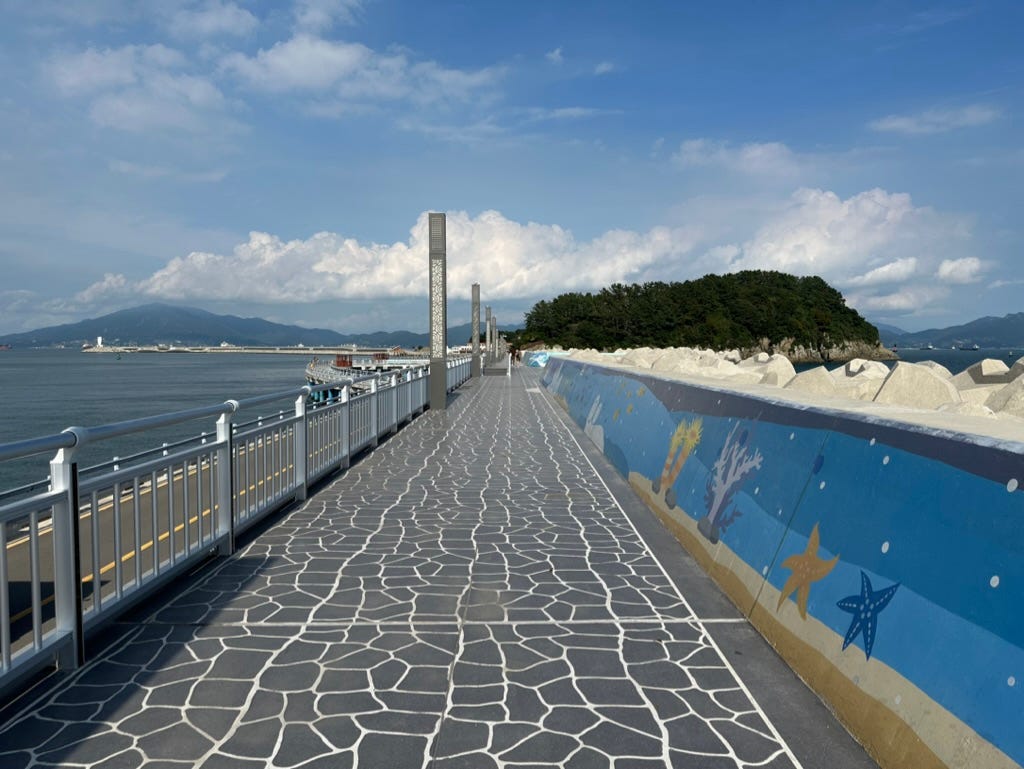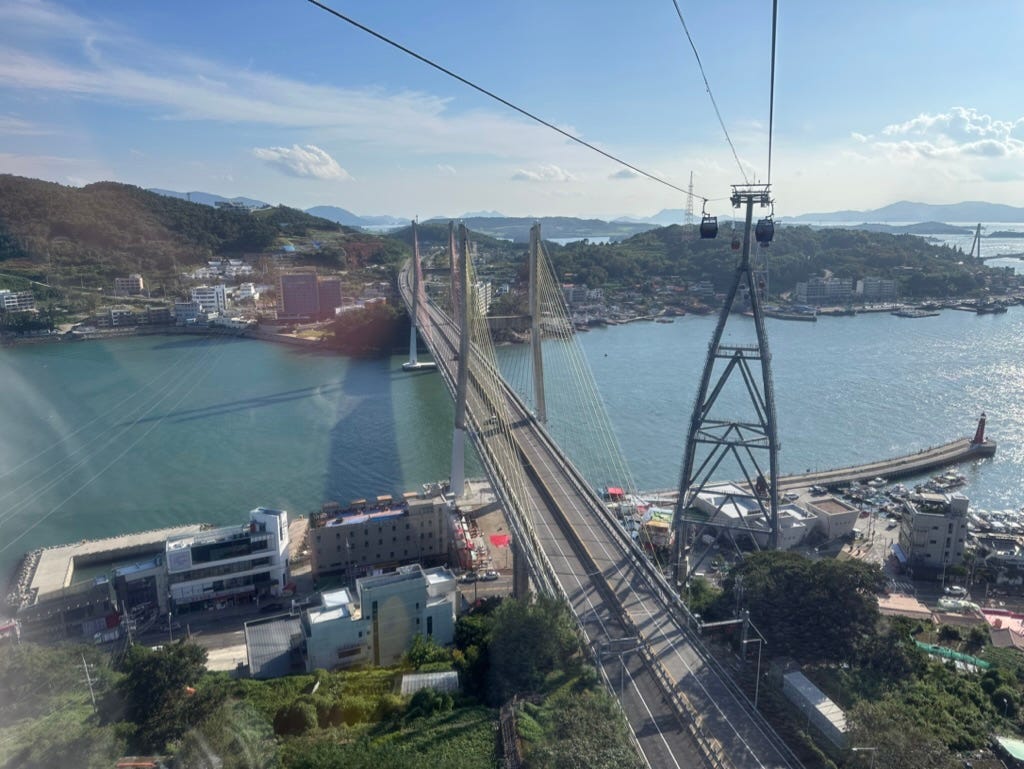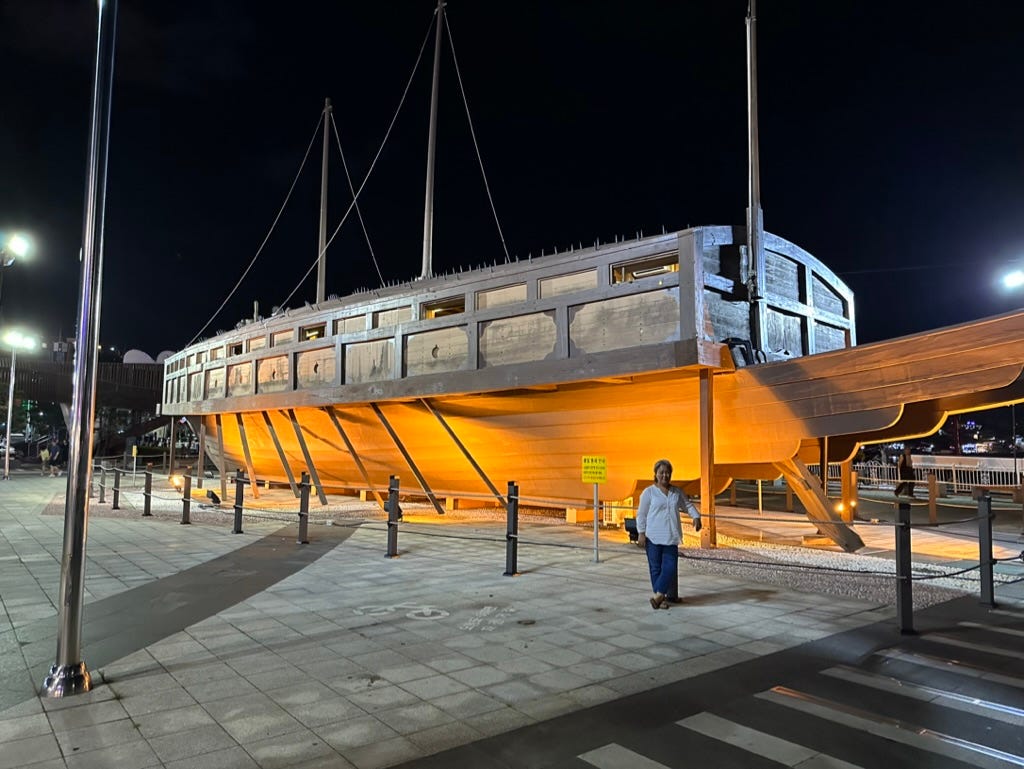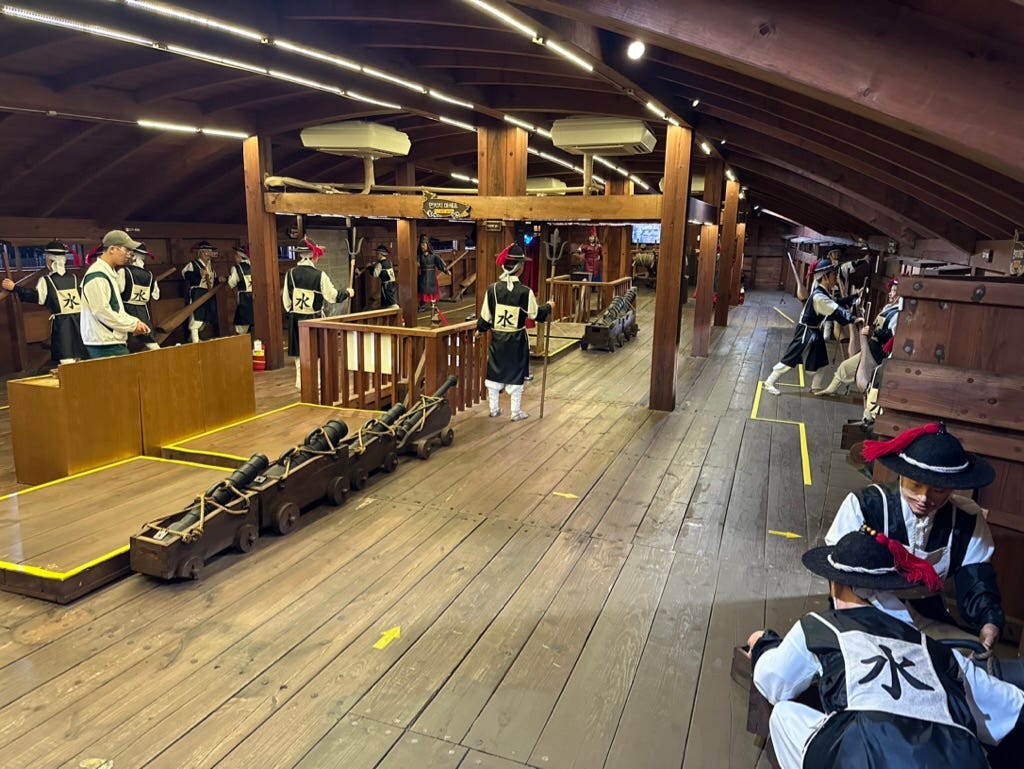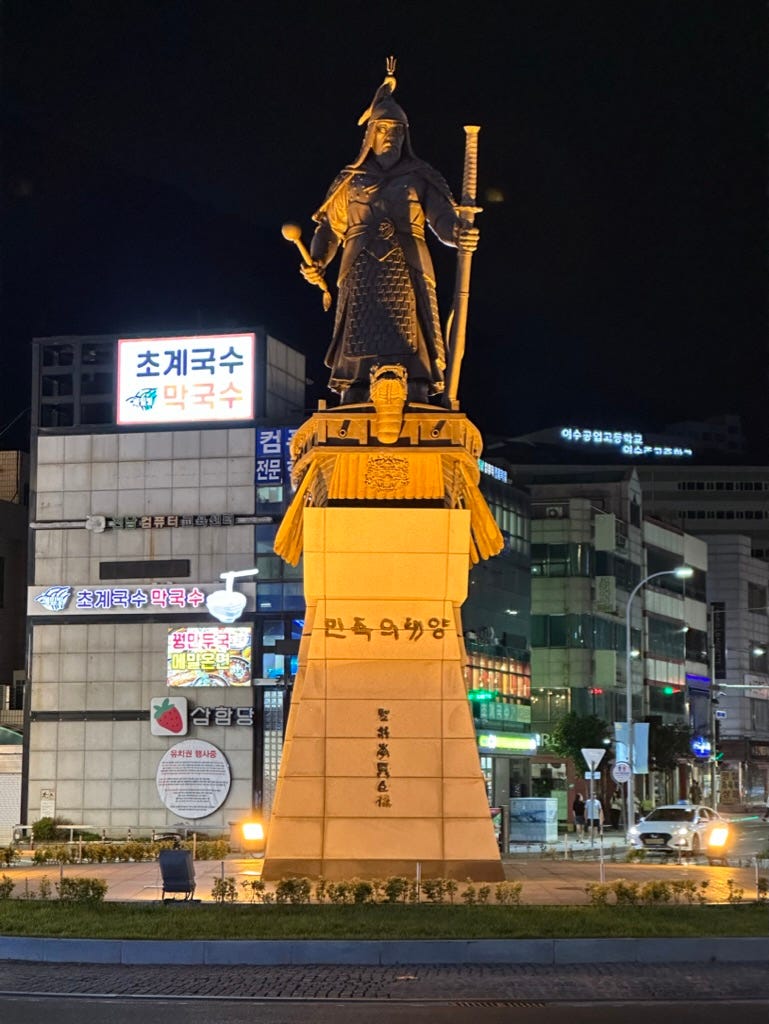South Korea - Chapter 10: Yeosu
The biggest little Korean city of which you've likely never heard
Our original plan was to leave Jeju Island by ferry. As it turns out, ferries around here don’t have seats. The idea of sitting on the floor of a ferry at sea for five hours was as unappealing to my in-laws as it was to me. Don’t get me wrong, I’m all for new experiences but I have no desire to eat a live tarantula either. There are some experiences I am quite certain that I can avoid and still feel I have lived a good life. Thus we decided we would be leaving Jeju by air. We left early for the airport to make sure we had plenty of time to avoid missing our inexpensive and non-refundable flight on Asiana Airlines which I briefly thought was the name of the airline in the TV show LOST (that one as it turns out was called Oceanic) . Once again it was time for a meal and once again the food at the airport did not disappoint.
This meal would cost me $20USD at least back home but here it was 15,000 KRW or just over $11USD. Good and yet inexpensive food. I’ll take that whenever I can get it.
My Father-In-Law wished to visit the city of Yeosu. I had never heard of it but then I’m no expert on Korea. Apparently it was a city he and my Mother-In-Law remembered well from the first 30 or so years of their lives that they spent in South Korea. I had no idea that visiting this city would lead to me learning about one of the greatest naval battles in history so read on!
Yeosu (which in Korean is spelled 여수시 and literally means Yeosu City - pronounced yeh-soo) sits on the southern coast of South Korea. It’s home to almost 275,000 people as well as 365 islands, only 48 of which are inhabited. I immediately started imaging owning my own island! Because of its location, it has cool summers, mild winters along with longer than usual springs and autumns. The airport in Yeosu is small (as I should have expected). The distance from the gate exit to baggage claim was very short. Jeannie had the brilliant idea that, like on Jeju, we see about renting a car. As I mentioned in a previous post, we had heard that renting a car in mainland Korea was not something that foreigners can typically do but it was worth asking. Sure enough, the helpful gentleman who spoke English quite well at the rental car counter, literally a stone’s throw from baggage claim, was more than happy to rent us a car. It was the fastest and smoothest rental car experience I have had in a long time. When we were ready to leave, he said he would take us to our car. That made we wonder just how far away from the airport the car might be. The answer to that question came seconds later as we followed him out of the front doors of the airport then headed right, down the sidewalk about 100 yards to a brand new Hyundai Sonata. It had only 475 kilometers on it or about or 295 miles or those of you still using the Imperial System. :) This car is very nice. Two big LCD screens for the displays, support for Apple’s CarPlay and USBC connectors. I’m fully geeking out on this car. I like that it’s more Star Trek: The Next Generation than Star Trek: The Original Series. The only thing that could have made it better would be if it had been electric.
For $88USD per day, it made perfect sense. Rather than rely on taxis and trains, we could get around on our own and use it to drive to our next destination.
As we drove from the airport to the place in which we were staying, Yeosu seemed like a city that surely had more than 275,000 residents but then, that’s what I thought about Jeju Island too. Yeosu is not too small and not too big. It’s just right. It’s got everything you’d want from a big city without what you don’t want. It’s got a quite varied geography as well with lots of tree-covered hills. Though it’s not Mediterranean in the same way that, well, the Mediterranean is (as is Southern California where I grew up), it somehow feels quite comfortable to me.
As is our custom, while Jeannie drove, I navigated. Finding places in Korea is challenging because the mapping apps we non-Koreans use with such speed and precision are severely handicapped in South Korea. They can’t seem to find nearly anything whether the name is specified in English or Korean. And for a sneak peak at the next chapter, our bad luck with Korean addresses will lead to an encounter with local law enforcement. This is only made worse by the fact that Korean addresses, like Japanese addresses, are only helpful to a point. They will get you near where you are going but not precisely to it. We ended up down near the harbor in the busy business district filled with what you’d expect from a seaside city: lots of fishing boats and vendors selling what those fishing boats brought in that day. It didn’t seem like a place where one would live. After driving around and around through narrow streets filled with places providing seafood before and after it has been cooked, we decided that I would get out of the car and try to find the place in which we would be staying while Jeannie looked for parking.
Being the outgoing and adventurous type, I walked up to the first person I could find, spoke the limited Korean I know, threw in some English with an intonation that said, “Can you please help a lost foreigner figure out where this place is?” and made lots of wavy hand gestures at my phone. The woman looked at the address in Korean then drew her phone from her purse at the speed of an old western gunslinger who has clearly earned his longevity, and started typing Korean into a different clearly far better local maps app with the sense of urgency of an experienced surgeon providing life-saving instructions to an intern fresh out of medical school. Having found the location, the look on her face went from delight to anxiety as she realized that she could not expect me to understand Korean well enough to follow her instructions. At that point she decided to employ her own set of wavy hand gestures by pointing down the street and signaling that I should go down two blocks. I can’t tell you how much English she speaks but thankfully she knows the the word, right. I smiled, nodded, thanked her in Korean and headed off.
Having followed her instructions to the hand gesture, I found myself feeling I was so close to where I needed to go and yet so far. I walked into the shop on the corner to find the husband and wife owners bickering over who knows what. I repeated by limited Korean, English with added intonation and wavy hand gestures. The 아줌마 (ajumma - which means older woman) immediately stopped bickering and started pushing me out the door. At first I thought she just didn’t have time for me as she had some very important bickering to finish but instead, she took me two doors down to a dark and unassuming stairwell that I’m an unsurprised I had missed. Her confidence that this was indeed the location gave me the confidence to tell Jeannie I had found it. As it turned out, Jeannie had found parking with in earshot of where I was standing.
The outside of the building is nothing to look at unless fish markets are your kink.
And the description failed to mention that the unit was on the 3rd floor with no available elevator. That might have been an obstacle for others in their 80s but not my in-laws. The view from the living room of the place in which we are staying made it all worthwhile.
Our living room window was like a 100 inch TV where we could watch ferries and fishing boats come and go as well as people watch to our heart’s content. It’s unfortunate that I didn’t take a picture at night as the lights made it quite beautiful. This, as it would turn out, is only one of many harbors that help make Yeosu the seaside city it is. Because Koreans are so thrifty when it comes to energy (and really, most other things as well), the apartments had a front screen door which many people utilized to create a breeze and keep cool instead of turning on the AC. These units are small so that did allow anyone walking by a view into their living rooms but I assume everyone knows each other around here.
Our host had told us that parking out front is free from 6PM to 9AM. That’s unsurprising given that it’s a business district. Like so many things in Korea that are different than in the US, how one pays for parking is very well thought out. Rather than pay upfront for your best guess as to how long you will be then keep checking your watch so that you can run feverishly back to feed the meter, in Yeosu (and perhaps in all of Korea), you pay when you leave. What a brilliantly simple concept. But how does that work? Could you not just leave without paying? No, the smart people that handle public parking here thought that through as well.
First, cameras are pointed at every parking spot. Leave without paying and they have your license plate number.
But more importantly, you can’t simply pull out of your unassuming parking spot without paying because it won’t let you. Your tires are blocked.
Once you have paid, this robo-parking attendant lowers, turns green and you can leave. It’s technology at its best. Easy to use, stays out of your way and gets the job done. That is, mostly. Yeosu apparently is a bit of a tourist town for Koreans but not so much for those of us that aren’t accustomed to reading the Korean-only user interface of the kiosk that one uses to pay for parking. Most we have encountered have a button labeled, “English” or an American flag (sorry Great Britain) that I can push to operate the application from the warm comfort of my native language but this one did not. Jeannie and her mom are fluent in Korean of course but neither have operated a parking kiosk like this before.
Still, after a few minutes of watching them scratch their heads then poke at it as if they were reading 1970s stereo instructions, they walked away with that expression that can only mean I hope we got it right.
The view truly is the best thing about the little apartment that would be our home for the next two days. The living room was large but had no couch. That sounds strange but Koreans are quite accustomed to sitting on the floor as the ferries made all too clear. Along the wall that held the windows was a long table with barstools. I guess they assume you will be looking out the window, not at the TV on the other side of the room.
The bathroom is not atypical of Korean bathroom. As is often the case, the shower is not a separate area from the rest of the bathroom. There’s no glass door. It’s just at one end of the bathroom. Now I know what you’re thinking. Doesn’t that mean the entire bathroom gets soaked any time someone showers? That’s certainly true when a non-Korean uses it. My guess is that those accustomed to all-in-one bathrooms have perfected the skill of containing spraying water to a one meter square area. Korean bathrooms also tend to include an electronic bidet. This one did not oddly enough but most do. Bidets are not at all common in the United States (though that is slowing beginning to change). It seems that at some point in US history they were somehow associated with French prostitutes. I can only imagine that this was misinformation spread by the marketing department of the leading US toilet paper company of the time. If you have never used one, it’s basically a carwash for your backside. Though instead of driving through it, with the machinery doing all the work, there’s a panel that thankfully has cute icons to help you control its various features so that you don’t have to become fluent in Korean to use one. This picture is from one of the other apartments in which we stayed. I will leave it to your imagination to figure out what they do.
And that will conclude your Korean cultural lesson for today.
Having dropped our bags, my Father-In-Law decided he wanted to rest so Jeannie, my Mother-In-Law and I headed out to find a place to eat. As we walked along the various seafood-selling vendors (all of whom were closing or about to close for the evening), we came across a shop that sold only kimchi. Not a fish, crab, squid or octopus in sight. Jeannie immediately recognized it as being the shop of the owner of the apartment in which we were staying. Jeannie walked in saying “Hello?” in Korean but no one was there. Suddenly from behind us a woman appeared who thought we were customers looking for kimchi. It was the shop owner who indeed was also the owner of the apartment. After introductions and finding out we were looking for a place to eat, she took us a few doors down to a restaurant where inside there were just three people eating, talking and clearly having a good time. One of them turned out to be her husband who introduced himself and then suggested that we look no further and eat there.
We were seated in the small restaurant that had perhaps 10 to 12 tables and was run by two women. When I say run, I mean they were the hostesses, the wait staff, the cooks, the bus people an did all of the business operations to run the place. Doing so much with just two people (or less) is why restaurants like this in Korea can be so profitable. The husband sat with us and started to tell us all about the area, ask questions about where we were from, how often we had to dodge tornados and gun fire, then explained that in addition to the apartment, kimchi store and his own acupuncture practice, they also owned some commercial real estate. He sat and talked with us for nearly our entire meal until his wife told him to give us some peace in which to eat. He smiled and they both said goodbye only to be replaced by one of the two owners of the restaurant who took over for them and talked to us until we were ready to leave.
The next day it was time to see the local sights. We had seen off to our left that the city has gondolas on a cable so we headed there. The ride afforded us a great view of various parts of the harbor and city.
At the other end of line was a tower with a few cafes and a great place to take pictures of the harbor.
It appears the harbor is busy enough to have a dry dock for ship repairs.
It’s also one of those places, common in Korea, where the great view is also where you can leave something behind to mark the occasion. These hearts were everywhere. This is really just a small sample of them.
For 5000KRW (about $3.75USD) you can purchase one, write messages on it then find a good place in which to tie it. Of course Jeannie and I did.
Far down below us was an island out to which the city had built a jetty to protect parts of the harbor from the ocean. This also allowed people to walk across it to the island. Our choices were an elevator ride down about 15 floors or descending via a path with many stairs not unlike the Stairs of Cirith Ungol that Gollum takes Frodo and Sam up in order to reach Mordor in The Lord of the Rings, but far more beautiful. Most people in their 80s would have gone for the elevator but my in-laws are not most people. We choose the latter.
And anyway, going down stairs is easier than going up, right? Of course, that’s not what Sam found out.
Having arrived at the bottom we headed out across the jetty.
Since we bought round trip gondola tickets, the way back gave me a chance to get a really nice picture of the suspension bridge we crossed on our way there earlier today.
When we returned to our apartment and with my in-laws finally tired out, Jeannie and I went for a short walk along the edge of the harbor. There we found that someone had built a full-sized model of a Korean warship from the 15th century, aptly named a, “Turtle Ship.”
Unlike European ships of the time, this one had a roof that was covered in spikes. Thus getting inside was difficult to say the least for any enemies that were foolish enough to try. It’s fairly big inside as well.
The top floor is where all the action took place while the stairway you see there lead to the lower deck where food and arms were stored and where the crew slept.
Walking a bit further we came across a statue of Yi Sun-sin, one of Korea’s greatest admirals from the 16th century. Clearly you wouldn’t want to mess with this guy.
Admiral Yi had many impressive victories but none are as impressive as at the Battle of Myeongnyang. The Japanese were invading Korea and after many naval battles, Yi’s fleet was down to just 13 ships and 200 men. Knowing that there were 333 Japanese warships nearby, the King of Korea sent a message to Yi telling him to abandon his ships and have his men join others in combat on land. Yi sent a message back that basically said, “I’m still alive and have ships under my command. The Japanese will be never be safe here.”
Outnumbered 25 to 1 he needed a great, no, brilliant plan. He sent a small scout vessel to within sight of the Japanese fleet. The Japanese followed this ship assuming it would lead them to Yi and his minuscule fleet. They followed it into a nearby harbor that had currents, eddies and whirlpools allowing only two ships to enter at a time. To make matters worse, the harbor had strong currents that reversed themselves every 3 hours or so which made it impossible to navigate for the Japanese Navy. The harbor was also surrounded by hills which Yi had filled with archers and cannons. Even better, that day the harbor was filled with a heavy mist reducing visibility substantially which would be a problem for the Japanese who didn’t know the harbor. As the Japanese warships entered, they found it impossible to wage battle against the tiny Korean fleet and surrounding cannons and archers. In the end Yi sank 31 Japanese ships, captured and killed their admiral and displaying his head on a pike to further humiliate the Japanese. The rest of the Japanese Navy decided not to risk anything further and left. The total casualties to Yi’s fleet were 10 crew men and no ships lost. It was a truly brilliant plan that was perfectly executed.
There’s a lot of bad blood between the Japanese and the Koreans. Jeannie and I noticed that, despite Korea’s proximity to Japan, we can count on one hand the number of Japanese cars we have seen in Korea. Virtually all foreign cars and American or European.
Our stay in Yeosu was short but so far, it’s the city I like the most by far. It feels relaxed, it’s got great weather, it’s on the coast and you can get into the mountains where there are substantial forests in less than an hour. If I were to live in Korea, Yeosu would be on the short list.

